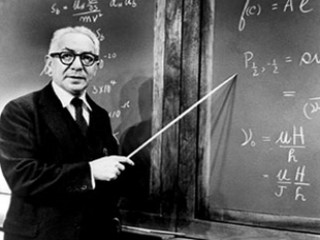
Isidor Isaac Rabi biography
Date of birth : 1898-07-29
Date of death : 1988-01-11
Birthplace : Rymanow, Galicia, Austro-Hungary(now Poland)
Nationality : Galician-American
Category : Science and Technology
Last modified : 2011-07-04
Credited as : Physicist, nuclear magnetic resonance, Nobel Prize for Physics (1944)
Isidor Isaac Rabi was born on July 29, 1898, in Rymanow in what was then Austria-Hungary. As an infant, he was brought to the United States, where his father engaged in the real estate business in New York City. Rabi attended Cornell University (1916-1919), obtaining a bachelor's degree in chemistry. Deciding to pursue graduate study in physics, he returned to Cornell (1922-1923) and then transferred to Columbia University, where in 1927 he obtained his doctoral degree. In 1926 he married Helen Newmark. The couple had two daughters.
Rabi studied in Europe (1927-1929), working with some of the most outstanding physicists. Otto Stern, with whom he remained for about a year, made the deepest impression on Rabi.
Immediately on his return to the United States, where he had accepted a position as lecturer in physics at Columbia, Rabi and his student V. Cohen exploited the atomic-and molecular-beam techniques Rabi had developed in Stern's laboratory. Together they proved that the sodium atom has four "hyperfine-structure" energy levels, which unambiguously fixed the "spin angular momentum" of its nucleus at a definite value, equal to 3/2 in units of 2π/h. A few years later, by using beams of atomic hydrogen and deuterium, Rabi and his coworkers confirmed the surprisingly large value for the magnetic moment of the proton which Stern had found in 1933. It was during the course of this work that Rabi developed still another new method, the resonance method, that has since become the basis for all precision atomic-and molecular-beam measurements.
From the point of view of "pure physics, " perhaps the most important measurements that have been made by exploiting Rabi's method have been those on the anomalous magnetic moment of the electron, the quadrupole moment of the deuteron, and the Lamb shift in hydrogen (which has become of great importance for the development of quantum electrodynamics). From the point of view of "practicality, " Rabi's method has found numerous applications, for example, in the highly precise time measurements associated with "atomic clocks, " in precise measurements of magnetic fields, and in the development of the laser, an exceedingly important and versatile instrument. For his atomic-and molecularbeam work and for his discovery of the resonance method, Rabi was elected to the National Academy of Sciences in 1940 and received the 1944 Nobel Prize.
In 1937 Rabi achieved the rank of full professor at Columbia. Three years later he became associate director of the radiation laboratory at the Massachusetts Institute of Technology (MIT), recently established to develop microwave radar and related equipment for military uses. This work, which was closely related to Rabi's past researches and which relied heavily on British contributions, was eminently successful. In 1948 he received the United States Medal of Merit and the King's Medal for Service in the Cause of Freedom for his wartime efforts.
Rabi was executive officer of the physics department at Columbia (1945-1948), during which time he increased the strength of the department, especially in high-energy and microwave physics. He was also instrumental in establishing the Brookhaven National Laboratory on Long Island in 1945, and he started the movement that resulted in the large high-energy laboratory (CERN) in Geneva, Switzerland. He was the chairman of the General Advisory Committee of the Atomic Energy Commission and served on the President's Science Advisory Committee and the United Nations Science Committee.
One of Rabi's most satisfying postwar achievements was his organization of a number of international United Nations Conferences on the Peaceful Uses of Atomic Energy. Like most physicists, he was deeply impressed by the awesome destructive power of the atomic bomb and worked unrelentingly to find means to ensure that the bomb would never be used again.
Communication is essential to understanding, and understanding is essential to unity: this was a major theme in Rabi's life, especially after the war. It applies not only to countries but also to intellectual disciplines. "What the scientist really desires, " Rabi wrote, "is for his science to be understood, to become an integral part of our general culture, to be given proper weight in the cultural and practical affairs of the world. Like the poet, the scientist would rather be read than praised." According to Rabi, what people of all disciplines sorely require is wisdom: "Without it, knowledge is dry, almost unfit for human consumption, and dangerous in application. … Wisdom makes itself most manifest in the application of knowledge to human needs."
Granted his sincere search for unity, it is not surprising that Rabi, after holding the Higgins professorship of physics for seven years (1957-1964), became the first university professor at Columbia. This professorship is without ties to any particular department. The last subject Rabi lectured on before his retirement in 1967 was "The Philosophical and Social Implications of 20th Century Physics." Rabi explained to his Columbia students, in reference to atomic weapons, "just because we got their first doesn't mean that we should have the power of life and death over the whole world."
Rabi died of a long-term illness on January 11, 1988 in New York City.
















